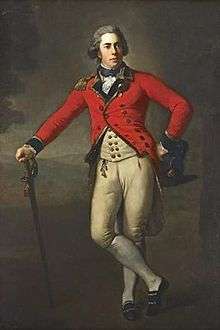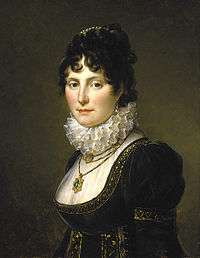Thomas Bruce, 7th Earl of Elgin
| The Earl of Elgin | |
|---|---|
 Thomas Bruce, 7th Earl of Elgin and 11th Earl of Kincardine by Anton Graff (around 1788). | |
| Born |
20 July 1766 Broomhall, Fife |
| Died |
14 November 1841 (aged 75) Paris, France |
| Title | Earl of Elgin |
| Tenure | 1771–1841 |
| Known for | Removal of Marble Sculptures from Parthenon |
| Nationality | British |
| Spouse(s) | Mary Nisbet |
Thomas Bruce, 7th Earl of Elgin and 11th Earl of Kincardine (/ˈɛlɡɪn/; 20 July 1766 – 14 November 1841) was a Scottish nobleman and diplomat, known primarily for the removal of marble sculptures (also known as the Elgin Marbles) from the Parthenon in Athens.[1]
Early life
Elgin was born in Broomhall, Fife, the second son of Charles Bruce, 5th Earl of Elgin and his wife Martha Whyte. He succeeded his older brother William Robert, the 6th Earl, in 1771 while he was only five.[1] He entered the army as an ensign in the 3rd Guards. He was elected as a Scottish Representative Peer in 1790, remaining one until 1807.
Diplomatic career
In 1791, he was sent as a temporary envoy-extraordinary to Austria, while Sir Robert Keith was ill. He was then sent as envoy-extraordinary in Brussels until the conquest of the Austrian Netherlands by France. After spending time in Britain, he was sent as envoy-extraordinary to Prussia in 1795.[2] Elgin was appointed as ambassador to The Porte in December 1798.
On 11 March 1799, shortly before setting off to serve as ambassador at Constantinople, Elgin married Mary, daughter and heiress of William Hamilton Nisbet, of Dirleton;[3] Elgin finally arrived at Constantinople on 6 November 1799.
Elgin was ambassador to the Ottoman Empire between 1799 and 1803; he showed considerable skill and energy in fulfilling a difficult mission, the extension of British influence during the conflict between the Ottoman Empire and France.[4] He departed Turkey at last on 16 January 1803.
Elgin with Parthenon Marbles
Acting on the advice of Sir William Hamilton, he procured the services of the Neapolitan painter, Lusieri, and of several skilful draughtsmen and modellers. These artists were dispatched to Athens in the summer of 1800, and were principally employed in making drawings of the ancient monuments, though very limited facilities were given them by the authorities. About the middle of the summer of 1801, Elgin received (as is said) a firman, from the Porte which allowed his lordship's agents not only to 'fix scaffolding round the ancient Temple of the Idols [the Parthenon], and to mould the ornamental sculpture and visible figures thereon in plaster and gypsum,' but also 'to take away any pieces of stone with old inscriptions or figures thereon.'[2] Due to the loss of the original firman, it isn't sure that the translation is correct.
The actual removal of ancient marbles from Athens formed no part of Elgin's first plan. The collection thus formed by operations at Athens, and by explorations in other parts of Greece, and now known by the name of the 'Elgin Marbles,' consists of portions of the frieze, metopes, and pedimental sculptures of the Parthenon, as well as of sculptured slabs from the Athenian temple of Nike Apteros, and of various antiquities from Attica and other districts of Hellas.[2]
Part of the Elgin collection was prepared for embarkation for England in 1803, considerable difficulties having to be encountered at every stage of its transit. Elgin's vessel, the Mentor, wrecked near Cerigo with its cargo of marbles, and it was not till after the labours of three years, and the expenditure of a large sum of money, that the marbles were successfully recovered by the divers. On Elgin's departure from Turkey in 1803, he withdrew all his artists from Athens with the exception of Lusieri, who remained to direct the excavations which were still carried on, though on a much reduced scale. Additions continued to be made to the Elgin collections, and as late as 1812, eighty fresh cases of antiquities arrived in England.[2]
The removal of about 1/2 of the frieze metopes, frieze and pedimental sculpture was a decision taken on the spot by Philip Hunt, Elgin's chaplain (and temporary private secretary, i.e. representative, in Athens), who persuaded the voivode (governor of Athens) to interpret the terms of the firman very broadly.
Lord Elgin bribed local Ottoman authorities into permitting the removal of about half of the Parthenon frieze, fifteen metopes, and seventeen pedimental fragments, in addition to a caryatid and a column from the Erechtheion. He used these antiquities to decorate his mansion in Scotland and then later sold them to the British Museum in an attempt to repay his escalating debt.
On the recommendation of a parliamentary committee, which also vindicated Elgin's conduct, the "Marbles" were bought by Great Britain in 1816 for £35,000, considerably below their cost to Elgin (estimated at £75,000), and deposited in the British Museum, where they remain.[1]
Later career
Elgin, who had been 'detained' in France after the rupture of the peace of Amiens, returned to Britain in 1806.[2] Finding that he could not get the British Museum to pay what he was asking for the marbles, Elgin sued his wife's lover for an appropriately high sum. He divorced Mary, for adultery, by legal actions in 1807 and 1808 in the English and Scottish courts—and by act of parliament—which caused much public scandal. Then, on 21 September 1810, he married Elizabeth (1790–1860), youngest daughter of James Townsend Oswald of Dunnikier. Elgin moved to the European continent.
Family

Elgin married twice. On 11 March 1799, he married Mary (1778–1855), only child of William Hamilton Nisbet, of Dirleton;[5] They had a son and three daughters:[5][3][6]
- George Charles Constantine (1800–1840), died unmarried, known by the courtesy title of Lord Bruce.[7]
- Mary, married on 28 January 1828, Robert Dundas
- Matilda-Harrie, married on 14 October 1839, John Maxwell son of Sir John Maxwell, 7th Baronet
- Lucy, married on 14 March 1828, John Grant of Kilgraston.
After their marriage ended in divorce Mary later married Robert Ferguson of Raith (1777–1846) who had been cited in the divorce. Elgin, on 21 September 1810, married Elizabeth (1790–1860), youngest daughter of James Townsend Oswald of Dunnikier. They had four sons and three daughters, including:[5]
- James Bruce, who became governor-in-chief of British North America and viceroy of India and successor to the Earldom.
- Robert Bruce (1813–1862), who became a Lieutenant-Colonel in the Grenadier Guards, married Katherine-Mary (d 1869), 2nd daughter of Sir Michael Shaw-Stewart, 6th Baronet.[8]
- Sir Frederick Wright-Bruce (1814), who became a diplomat
- Thomas Charles Bruce (1825), who became MP for Portsmouth
- Charlotte-Christian, married on 1 July 1850, to Frederick Locker, grandson of Rear-Admiral Sir Edward Locker
- Augusta Frederica Elizabeth, lady in waiting to Queen Victoria, and married to Arthur Stanley, who became Dean of Westminster.
- Frances-Anne.
Elgin died, on 4 November 1841, aged 75, in Paris.[9]
See also
Notes
- 1 2 3 Encyclopædia Britannica, "Thomas Bruce, 7th earl of Elgin", O.Ed., 2008
- 1 2 3 4 5 Wroth 1886.
- 1 2 Burke's Peerage (1939 edition)
- ↑ Christopher Hitchens, The Elgin Marbles: Should They Be Returned to Greece?, 1998, p.p.10-11
- 1 2 3 Burke 1852, p. 364.
- ↑ "Lord Bruce died, after a lengthened illness, ... at Talaton, Devon, where he had been residing for the benefit of his health. The deceased, George Charles Constantine Lord Bruce, who was eldest son of the Earl of Elgin, by his first marriage with Miss Nisbet, which marriage was dissolved by act of Parliament in 1808, was born the 5th of April, 1800, and was brother of Lady Mary Chichester, the lady of Mr. R. A. Chichester, M.P., Lady Matilda Maxwell, and Lady Lucy Grant. The Hon. James Bruce, the noble earl's eldest son' by his second marriage, born July 20, 1810, is now heir to the family honours.(Courier staff 1841, p. 4)"
- ↑ "Dec, 1. 1840 At Talaton, where he had been residing for the benefit of his health, aged 40, George Charles Constantine, Lord Bruce, eldest son of the Earl of Elgin. He was of Christ Church, Oxford. He died unmarried, and his half brother, born in 1816, is now heir apparent to the Earldom(Urban 1841)"
- ↑ Lang 1987, p. 350 footnote 1.
- ↑ St Clair 2004.
References
- Burke, John Bernard (1852). A genealogical and heraldic dictionary of the peerage and baronetage of the British Empire (14 ed.). Colburn. p. 364.
- Courier staff (14 May 1841). "NECROLOGY.". The Courier (Hobart, Tas. : 1840 - 1859). Hobart, Tas.: National Library of Australia. p. 4. Retrieved 5 November 2011.
- Lang, Cecil Y. (1987). Lang, Cecil Y.; Shannon, Jr., Edgar F., eds. The Letters of Alfred Lord Tennyson: 1851-1870. 2. Harvard University Press. p. 350. ISBN 978-0-674-52584-9.
- Urban, Sylvanus, ed. (January 1841). "Obituary: Lord Bruce". The Gentleman's magazine. 170. J.B. Nicolas and Son. p. 106.
- St Clair, William (Sept 2004; online edn, Jan 2008). "Bruce, Thomas, seventh earl of Elgin and eleventh earl of Kincardine (1766–1841)". Oxford Dictionary of National Biography. Oxford University Press. Retrieved 20 September 2008. Check date values in:
|date=(help)
- Attribution
 This article incorporates text from a publication now in the public domain: Wroth, Warwick William (1886). "Bruce, Thomas (1766-1841)". In Stephen, Leslie. Dictionary of National Biography. 7. London: Smith, Elder & Co. pp. 130–131.
This article incorporates text from a publication now in the public domain: Wroth, Warwick William (1886). "Bruce, Thomas (1766-1841)". In Stephen, Leslie. Dictionary of National Biography. 7. London: Smith, Elder & Co. pp. 130–131.
External links
 Media related to Thomas Bruce, 7th Earl of Elgin at Wikimedia Commons
Media related to Thomas Bruce, 7th Earl of Elgin at Wikimedia Commons
| Diplomatic posts | ||
|---|---|---|
| Preceded by Viscount Torrington |
British Minister in Brussels 1792-1794 |
French Conquest |
| Preceded by Lord Henry Spencer |
British Minister to Prussia 1795–1799 |
Succeeded by The Earl of Carysfort |
| Preceded by Francis Jackson |
British Ambassador to the Ottoman Empire 1799–1803 |
Succeeded by William Drummond |
| Honorary titles | ||
| Preceded by The 22nd Earl of Crawford |
Lord Lieutenant of Fife 1807 |
Succeeded by The 22nd Earl of Crawford |
| Peerage of Scotland | ||
| Preceded by William Bruce |
Earl of Elgin Earl of Kincardine 1771–1841 |
Succeeded by James Bruce |